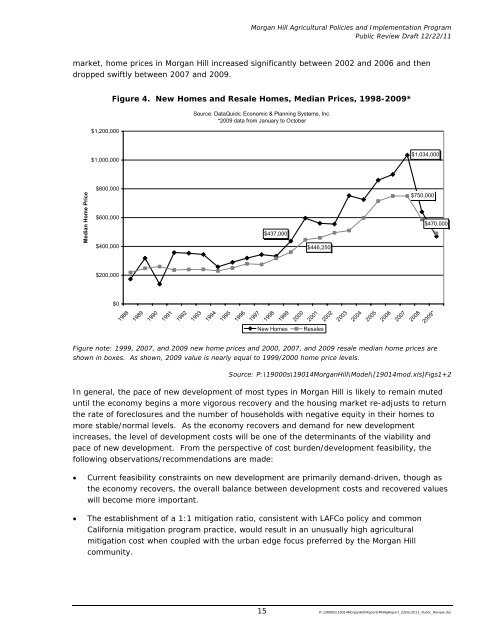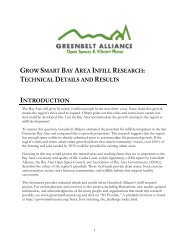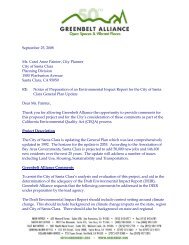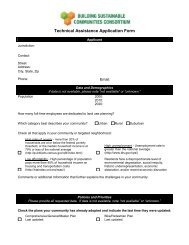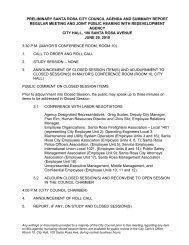Morgan Hill Agricultural Policies and Implementation Program
Morgan Hill Agricultural Policies and Implementation Program
Morgan Hill Agricultural Policies and Implementation Program
Create successful ePaper yourself
Turn your PDF publications into a flip-book with our unique Google optimized e-Paper software.
<strong>Morgan</strong> <strong>Hill</strong> <strong>Agricultural</strong> <strong>Policies</strong> <strong>and</strong> <strong>Implementation</strong> <strong>Program</strong><br />
Public Review Draft 12/22/11<br />
market, home prices in <strong>Morgan</strong> <strong>Hill</strong> increased significantly between 2002 <strong>and</strong> 2006 <strong>and</strong> then<br />
dropped swiftly between 2007 <strong>and</strong> 2009.<br />
$1,200,000<br />
Figure 4. New Homes <strong>and</strong> Resale Homes, Median Prices, 1998-2009*<br />
Source: DataQuick; Economic & Planning Systems, Inc.<br />
*2009 data from January to October<br />
$1,000,000<br />
$1,034,000<br />
Median Home Price<br />
$800,000<br />
$600,000<br />
$400,000<br />
$437,000<br />
$446,250<br />
$750,000<br />
$470,000<br />
$200,000<br />
$0<br />
1988<br />
1989<br />
1990<br />
1991<br />
1992<br />
1993<br />
1994<br />
1995<br />
1996<br />
1997<br />
1998<br />
1999<br />
2000<br />
2001<br />
2002<br />
2003<br />
2004<br />
2005<br />
2006<br />
2007<br />
2008<br />
2009*<br />
New Homes<br />
Resales<br />
Figure note: 1999, 2007, <strong>and</strong> 2009 new home prices <strong>and</strong> 2000, 2007, <strong>and</strong> 2009 resale median home prices are<br />
shown in boxes. As shown, 2009 value is nearly equal to 1999/2000 home price levels.<br />
Source: P:\19000s\19014<strong>Morgan</strong><strong>Hill</strong>\Model\[19014mod.xls]Figs1+2<br />
In general, the pace of new development of most types in <strong>Morgan</strong> <strong>Hill</strong> is likely to remain muted<br />
until the economy begins a more vigorous recovery <strong>and</strong> the housing market re-adjusts to return<br />
the rate of foreclosures <strong>and</strong> the number of households with negative equity in their homes to<br />
more stable/normal levels. As the economy recovers <strong>and</strong> dem<strong>and</strong> for new development<br />
increases, the level of development costs will be one of the determinants of the viability <strong>and</strong><br />
pace of new development. From the perspective of cost burden/development feasibility, the<br />
following observations/recommendations are made:<br />
• Current feasibility constraints on new development are primarily dem<strong>and</strong>-driven, though as<br />
the economy recovers, the overall balance between development costs <strong>and</strong> recovered values<br />
will become more important.<br />
• The establishment of a 1:1 mitigation ratio, consistent with LAFCo policy <strong>and</strong> common<br />
California mitigation program practice, would result in an unusually high agricultural<br />
mitigation cost when coupled with the urban edge focus preferred by the <strong>Morgan</strong> <strong>Hill</strong><br />
community.<br />
15 P:\19000s\19014<strong>Morgan</strong><strong>Hill</strong>\Report\MHAgReport_22Dec2011_Public_Review.doc


